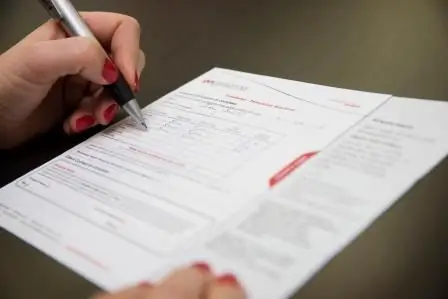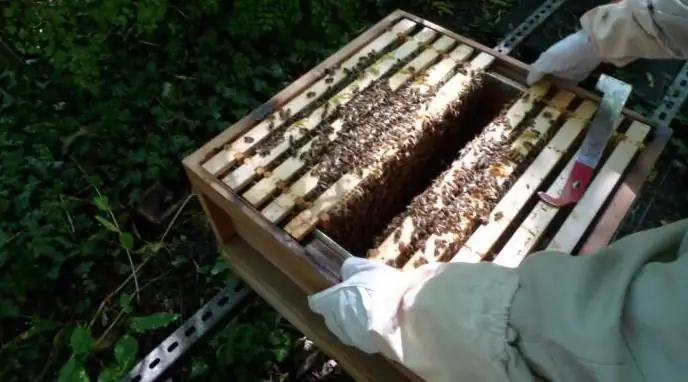2026 Author: Howard Calhoun | [email protected]. Last modified: 2025-01-24 13:10:31
In autumn, a new stage begins for the beekeeper, an extremely responsible one. Ahead of winter, which will never deceive an experienced beekeeper with little activity in the hives. This is a very difficult and very insidious period. At this moment, without exaggeration, the further fate of the entire apiary is in the hands of a person. In order for every single bee colony to winter safely, autumn feeding of bees is necessary.

Why is it needed?
Firstly, there may be one or more reasons why the bees could not provide themselves with enough food for the winter. Feeding replenishes them. This is her main task.
Secondly, the main honey collection has devastated the hive from honey, and its withdrawal must be compensated.
Thirdly, it is necessary to replace rapidly crystallizing honey, and especially honeydew, which is often deadly dangerous for bees. In return, they should get enough quality honey (syrup).
Fourthly, autumn feeding of bees is a great occasionarrange for them a "session" of therapeutic and prophylactic drugs.
Feeding in the fall is a feature that the bees should get the most easily digestible product. They no longer have the time or energy to do the same work as in the summer. And a person can help them with this. So, how to prepare bee food?

First of all, it is clear that it must be sugar syrup. And you need to make it in the best proportion, extremely facilitating processing. This proportion is achieved if you take 3 kg of sugar for 2 liters of water. You will get a 64% solution. The water must be soft so as not to accelerate the crystallization of the syrup. And sugar - only light, no options. Autumn feeding of bees is prepared in a clean bowl. Water is boiled, sugar is poured there, it is stirred until completely dissolved. The syrup must be brought almost to the boiling point, then immediately removed from the heat so that the sugar does not burn and hopelessly spoil all the top dressing. And now - a little trick, because, unlike sugar syrup, flower honey has a characteristic acid reaction. To imitate it, 70% vinegar essence is added to the syrup (0.3 g per 1 kg of sugar). As soon as the prepared autumn feeding of bees cools down to about 30 degrees, it can be carried to the hive for distribution. The colder the syrup, the more reluctant the bees will take it.

Now let's talk about a very important thing - the timing of feeding. It should start when the main one ends.bribes and the pumping of honey stops. It's August. In principle, two weeks can be met. But if this operation in some bee colonies is delayed for some reason, you must always remember: feeding the bees for the winter should be stopped until September 10th. Why?
Syrup processing is a hard job for bees, and those individuals who do this will definitely not survive until spring. They should be replaced by young bees that have not yet been loaded, just released "into the light". If top dressing is delayed until September 10, they willy-nilly have to join in the processing of syrup. The flow of nectar into the nest will continue. The uterus will decide that there are bribes and will continue to lay eggs. Young bees will also die. They will be replaced by those who came out of the brood too late: cold weather will come in which you cannot fly. In the absence of the first flyby, young bees will begin to suffer from diarrhea right in the hive, and this is a mortal threat to the entire bee colony. See what terrible consequences delaying the feeding of bees for the winter can lead to? Please don't let this happen.
Recommended:
Queen bee. Queen bee: photo, breed, description

The uterus is the only female in the family capable of laying eggs. Its main distinguishing feature is the presence of reproductive organs. It is the quality of the queens that determines the productivity of the hives, and, consequently, the profitability of the apiary. There are several types of such bees. At the same time, the uterus can be removed both artificially and naturally
Symbols in the time sheet. How to fill out a time sheet (sample)

Working time and its accounting are important components of any organization, allowing you to control the activities of the company and discipline employees. In order to simplify this procedure, a special form was developed - a time sheet
Car mini-washes - fast, cheap and efficient

Car mini-washes are presented in a wide range. How to choose the one that is right for you?
Care and feeding of strawberries in spring and autumn

You can choose the optimal diet for strawberries with top dressing using both organic and mineral fats, as well as products that are not fertilizers, but can be successfully applied to this crop. It is most rational to use a mixed type, which combines the use of mullein, bird droppings with yeast and synthetic fertilizers
Feeding bees for the winter with sugar syrup. Time and amount of feeding

When is bees fed for the winter with sugar syrup? Syrup recipe. The amount of bait per bee colony

